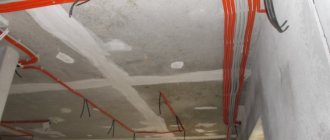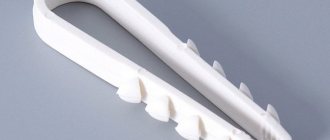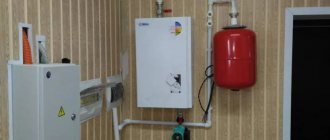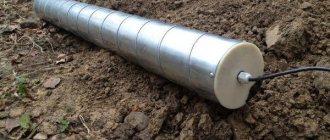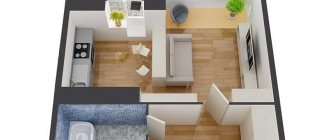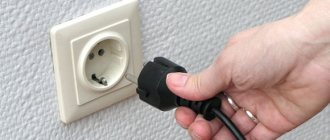Dowel-clamp design
The cable is fixed using dowel clamps. With this option, installation is divided into 2 stages. This fastening has two properties: the effect of the part that holds it, and the properties of the tightening clamp.
The simple type of clamps is similar to an 8mm clamp. These clamps have teeth; when installed, they adhere tightly to the wall.
Advantages and disadvantages of dowel clamps
This type of installation has quite a few advantages:
- Only one fastening element is used, and not a set with a clamp;
- Quick installation of just one part;
- The mount can withstand heat up to 80 degrees;
- Resistance to ultraviolet rays;
- Simple repair;
- Resistant to heavy weights.
But there are also disadvantages:
- Heat deformation
- This method looks bad in an apartment or house
Dowel fastener for cable
Regardless of the type of dowel clamps, the main condition is the presence of a hole in the wall into which it will be driven.
Calculation of the number of dowels
When calculating the number of dowel clamps on a cable line, several factors should be taken into account:
- the maximum weight that one dowel can support (specified in the quality certificate or technological passport);
- diameter – depends on the dimensions of the corrugation or cable bundles;
- length - related to the maximum weight, but also indicates the thickness of the load-bearing surface (this indicator is especially relevant when fastening to plywood or chipboard);
- the material of the wall or ceiling to which the dowel-clamp is attached - the fastener must withstand installation into the wall, and any deformation significantly reduces the maximum permissible load.
Hidden electrical installation
Let's consider the main options for fixing the cable for hidden installation using dowel clamps.
Dowel clamp for flat cable
Fasteners are ideal for securing a single flat wire. After drilling the hole, lay the cable, and then nail the dowel-clamp to the desired surface.
A similar element is developed specifically for a round cable or corrugated pipe. This is the best method when the corrugation is placed under a suspended ceiling, which ensures reliable and permanent fixation. Don’t forget to select a dowel clamp that matches the diameter of the corrugation or cable being secured.
Self-adhesive pad
It was written above that self-adhesive pads should be used for metal surfaces. The cable is then secured to the backing on the wall using a nylon tie.
Another option is to drill a hole and install an anchor into which a self-tapping screw, previously threaded through the platform, is screwed. The tie allows you to connect the cable to the substrate. This option is suitable for fixing thin wires of the UTP and CAT categories, but is practically useless for electrical wiring.
Fixation with cable clamps
You can use special cable ties that are suitable for heavier wiring with larger gauge cables. The products provide reliable protection against mechanical damage, maintain the integrity of the insulation and are suitable for single- and multi-core wires of different voltages.
Outdoor wiring
Now let's talk about options for fastening the cable with open routing.
How to fix a thin cable
In this case, you can use nail clips suitable for television or telephone wires. You should select staples of a size that matches the diameter of the cable. On the other hand, choosing the right product is problematic. Situations often arise where the nails are too short or the plastic keeps breaking.
Let's consider an alternative method. Stock up on wire cutters, thin nails and pieces of clamps.
Follow these steps:
- Hammer a nail into one of the edges of the clamps.
- Insert the wire and bend the free end of the clamp.
- Drive the nail into the wall, adjusting the diameter of the nail to match the cable dimensions.
Fixation for low-voltage cable using clips
A mounting gun is the best option for attaching corrugation or wire to a solid concrete wall. To do this, attach a mounting pad to the muzzle and shoot. Under the corrugation, ordinary 16 mm clips are suitable, the installation of which is carried out using a self-tapping screw and dowel. Dimensions are selected strictly according to the diameter of the pipe.
The main advantage of clips is the possibility of simultaneous installation of several wires; the disadvantage is high financial costs compared to other methods that involve the use of other fasteners.
DKS clips are considered to be of higher quality, for shooting which you can use a Toua pistol. This is a universal tool with a wide range of action that simplifies working with plastic parts.
Fastening the wire with a screwdriver
Junction boxes are attached in several basic ways, including the use of screws and dowels. But not every mounting gun is suitable for working with them: when fired from more powerful models, the box may simply break into pieces. It is best to pre-drill a hole with a diameter of 10 mm, and then secure the box with a screwdriver.
Important! It is best to shoot black mounting pads, since white ones are often less durable and fall apart quickly.
Installation of cable channels
When laying open wiring, special cable channels can be used. They are sold in any construction stores. Screws are used for mounting to the wall. More durable concrete walls should be pierced with anchors, and then the screws should be screwed in. The parts are easy to dismantle and reuse and can withstand the load exerted by the structure.
Despite the wide variety of fasteners for fixing cables, corrugations and wire bundles, dowel clamps are the simplest and most convenient components, ideal for open installation of electrical wiring. For apartments, the option is less popular, since the wiring is often hidden. For industrial purposes, dowel clamps will be the best solution.
Application of dowel clamp
A dowel clamp is used mainly for fastening small wires reaching a length of no more than twenty-five millimeters.
When choosing, you should pay attention to the following parameters:
- Size – its value may be indicated incorrectly;
- Shape - there are many different wires, and fasteners are created for them;
- When the product was manufactured. Poor quality polymers can stretch quickly;
- Cost – cheap fasteners are mainly made from low-quality materials;
The clamps can be mounted in any strong ceiling, but if it is weak, it is better to use a butterfly dowel.
Selection criteria and features
The parts can be installed in almost any material, not distinguished by thinness and fragility. These can be concrete blocks, brick, wood and wood-based materials (provided they are thick enough) - plywood, chipboard. But for fixing to thin sheets (for example, plasterboard), you need to use butterfly dowels.
When purchasing parts, you should pay attention to the minimum thickness of the load-bearing surface they are designed for. This is especially important when mounting on chipboard or plywood sheets.
In addition to the dimensions and type of construction, when choosing fasteners, it is taken into account what cable structure it is designed for - round or flattened.
You also need to pay attention to the production date . Often clamps are made of nylon, which is not a very strong material. It is prone to stretching during use. Parts are produced with the expectation of 2 years of use from the date of manufacture (not installation), so it is better to take fasteners manufactured no later than 6 months before purchase.
Valera
The voice of the construction guru
Ask a Question
Nylon and polyethylene are cheap materials, but they do not last long. However, on sale you can find parts with halogen additives that are durable. The price of such fasteners is correspondingly higher. They are worth purchasing if you plan to maintain the open routing and location of the cables for a long time.
Types of dowel clamps
The fasteners are the same, as they are specialized, but they are made of either metal or plastic.
Plastic fasteners
Dowel clamps for cables that have a flat shape are more common than regular ones. Such fastenings include brackets, etc. For flat-shaped cables, herringbone clamps are used, which are similar to brackets, only they are slightly modified.
By design features
There are 3 types of designs:
- Bracket - a strip made of plastic, has teeth, can fix cables with a thickness of up to 24 mm.
- The fastener is spacer, they call it “helicopter”. It is used to fasten wires and pipes, the weight of which reaches approximately 8 kg.
- It is used for fixing wires and pipes in the wall or ceiling, the thickness of which can reach up to 35 mm. There are 2 more types of spacer dowels.
The second type is a fastener that resembles an arc. This type is used when fastening cables of a certain thickness. The thickness parameters must match.
The installation platform with a clamp is a regular plastic dowel, but there is a loop at the end. The clamp is installed in this loop. This has one advantage: the clamps can be tightened.
By material
Fasteners are made from various materials:
- Nylon - designed for high loads. At high temperatures, this material can shrink by 5 times. Because of this, it is not advisable to use it.
- Polyethylene is vulnerable to ultraviolet radiation, which is why it is not used outdoors. Over time, due to its effects, it becomes weaker.
- Polypropylene is the most durable type, but is vulnerable to sunlight. Most often used inside buildings.
Clamps on the wall: durable, aesthetically pleasing
So, dowel clamps, or staples in other words: what kind of device is this? What are they made of, how much are their options in demand both by professionals and by everyone who makes something for themselves around the house or dacha. And most importantly: how firmly do they hold the attached materials, how much do they cost?
Read below for answers to these questions about this dowel for open laying of any type of cable, its restoration and quick replacement.
Metal dowel clamp
The metal in the dowel clamp is used for higher strength and fixation.
A dowel-clamp “bug” is a regular dowel for a self-tapping screw, it has a press clamp, a single-legged clamp with a certain diameter. The diameter can reach thirty-two millimeters and withstand the weight of cables up to ten kilograms. The wire must have another layer of insulation at the attachment point.
The maximum weight varies depending on the mount, usually up to 15 kg.
When using another method, the weight can reach 3 kg. It consists in the fact that you need to fix the tape through a special hole in the middle. You need to cut off a small part of the clamp, and wrap the rest of the wire around it and squeeze it tightly with pliers. Of course, the cable will become more secure, but will withstand a maximum of 3 kg.
Dowel clamp with wire tape. Its peculiarity is that the clamp is made from wire that is resistant to high temperatures. The buckle can help secure wires of different thicknesses. The load that is allowed is 1.5 kg. If there is no buckle, the wire becomes twisted.
Such products are made from durable metal, such as galvanized steel. In wet rooms, brass screws are used.
Material
Dowel - clamps are made of materials such as plastic and metal.
The most popular material for making plastic dowel clamps is nylon. The material can easily withstand heavy physical activity and high temperatures. However, the fastener is only suitable for mounting wires and non-heating pipes.
Polyethylene fasteners are low cost, but cannot withstand direct sunlight, so they are used exclusively indoors.
Polypropylene products are also sensitive to light, but may contain special additives that prevent them from deteriorating. However, the use of such additives significantly increases their price.
For metal products, galvanized steel and brass are used.
Options
A dowel is not a fastener, as everyone thinks, but a part that more reliably fixes a self-tapping screw.
Most often, products made from plastic are regulated in technical specifications according to standards that are suitable for consumers. Also, GOST does not include modern types.
Calculation of dowels
When selecting, they look at the following factors:
- Maximum permissible weight. The value of this parameter is determined using a heavy load. Manufacturers indicate this parameter on the certificate;
- The second parameter is diameter. Using this parameter, determine the thickness of the cable;
- Length – shows how long the load-bearing surface should be;
- The material from which the wall is made. You need to choose a material that is quite durable or changes its shape and expands, which can fix the entire structure much more strongly.
Technology
The installation procedure depends on the specific shape and design. First, markings are made on the wall for fastenings. The dowels are located at a distance of 0.25 m, because at a large distance the wire begins to bend due to its weight. When bending, the distance decreases to 10cm.
Then holes are made in the wall with a diameter similar to that of a dowel; the length should be approximately 1.5 cm longer. The cable is laid according to the markings, but it cannot be sewn up or pulled too tightly.
During installation, the dowel is threaded through the cable and driven into the hole. Because of the teeth on the dowels, the structure is tightly fixed.
